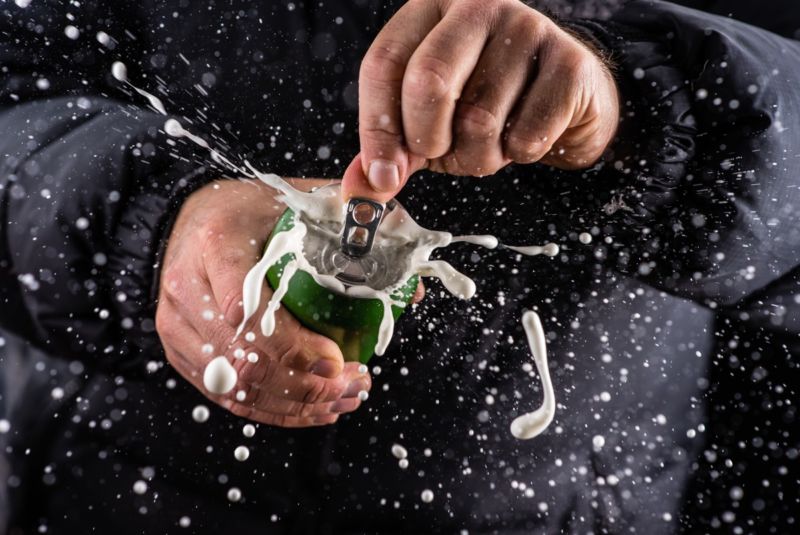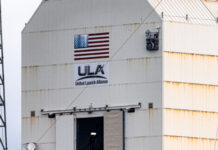
On the eighth day of Christmas —
The best strategy for a shaken beer can is just to wait for the fizz to settle

Enlarge / Danish physicists tested 1000 cans of lager—for science!
simonkr/Getty Images
Anyone who’s fallen victim to the old “opening a shaken beer can” prank has likely heard that tapping the side of the can before opening it can keep the beer inside from fizzing over. It’s a fun bit of folk wisdom, but apparently the science doesn’t bear it out. Danish scientists from the University of Southern Denmark (USD) in Odense put the tapping strategy to the test, and found it really doesn’t work. They summarized their findings in a recent paper posted to the physics arXiv.
Beer is a surprisingly popular subfield of study for scientists. There was a 2011 Irish study on bubble nucleation in stout beers, for instance, and in 2016, scientists demonstrated how beer foam reduces sloshing of beer as it’s poured into a glass, as well as enhancing the flavor. Back in 2013, Javier Rodríguez-Rodríguez, a physicist at Carlos III University of Madrid, and several colleagues presented experimental and computer simulation findings of why beer cans foam up so much after being shaken, at a meeting of the American Physical Society’s Division of Fluid Dynamics. They concluded that the foaming over stemmed from a series of waves.
“Actually, the laws of physics that control the development of these beer mushroom clouds are the same as [those that drive] the development of the cloud in an atomic bomb,” Rodriguez told NPR’s The Salt at the time. “Obviously, there’s no nuclear stuff in the beer. So the source of the explosion is very different, but the mushroom cloud that you see is very similar.”
Video by Javier Rodríguez-Rodríguez, Almudena Casado, and Daniel Fuster.
The initial tap to the bottle sends a shock wave through the glass to the bottle’s bottom. The energy from the wave transfers to the beer inside sending a second shock wave up toward the beer’s surface. It then bounces back again and keeps moving back and forth through the liquid until its energy dissipates.
The wave motion and changing pressure knocks free tiny gas pockets trapped inside microscopic imperfections in the glass bottle. The pockets implode and create clouds of smaller bubbles from the dissolved carbon dioxide in the beer. Though these bubbles can quickly grow up to three times larger than their original size, that alone is not what makes the bottle overflow with foam. Individual plumes of bubbles float up through the beer, building up speed as they get bigger, until they burst out of the bottle’s top in a shower of foam.
USD’s Elizaveta Sopina and Elliot J. Brown, co-authors of this latest paper, came up with the idea to test the hypothesis and possibly put an end to the dreadful scourge of excessive beer spillage. “This is inefficient, as fizzing reduces the amount of beer available for consumption and results in waste,” the Danish authors wrote of the rationale behind their experiment. “Beer spray can also stain clothes or surrounding objects, and there is also an unpleasant and socially undesirable side effect.”
Whether or not tapping or flicking a shaken helps lessen the fizzing and beer lossage—while based on reasonable hypothetical assumptions—had never been rigorously tested, although anecdotal evidence suggested it was ineffective. “Given the strong Danish tradition in beer brewing and consumption, and an emerging trend in exploring alcohol-related urban myths, we set out to settle this matter with high-quality evidence,” the authors wrote.

Enlarge / The experimental setup: cans randomized to the shaking group were claimed onto a shaker in batches of three or four.
E. Sopina et al/arXiv
Over a thousand cans of lager were provided by Carlsberg Breweries A/S for the experiment, although some were excluded due to damage or errors in the experimental process. In the end, 1000 cans were successfully tested on a Friday in May of 2018. The cans were randomly assigned (using Microsoft Excel’s random number generator) to one of four groups: unshaken/untapped, unshaken/tapped, shaken/untapped, and shaken/tapped. Each can was shaken for two minutes using an industrial shaker, equivalent to what cans of beer would experience while being transported in a bicycle for ten minutes (a common means of delivering beer in Denmark).
Three teams then weighed the cans, and tapped (or did not tap, depending on the group in question) cans three times on the side with a single finger. Then they opened the cans, “absorbed any beer loss using paper towels,” and finally re-weighed the cans to determine beer loss. Initially, the participants opened the cans with their hands, but apparently this caused “finger and nail-bed pain,” so they were provided with stainless steel butter knives to open the remainder of the cans.
But the tapping of the cans was still done manually. The co-authors considered automating that process, too, but decided against it, since “the aim of the research was to determine if this effect would be observable in a realistic use case, not in an over-engineered laboratory setting.”

Enlarge / Graph showing the change in beer can mass by shaking and tapping.
E. Sopina et al./arXiv
The result: the researchers found no significant difference in terms of beer loss between shaken cans that were tapped and those who weren’t. (The same held true of unshaken cans.) They suggested a possible explanation: the barley proteins in the beer may stabilize the bubbles, keeping them from rising to the top of the can. Further experiments would be needed to determine is tapping might reduce fizzing for other carbonated beverages, like soda.
However, one of the teams lost significantly less beer during the experiment than the others. “The most likely explanation for this is that, unlike other teams, Team 3 was exclusively comprised of engineers, who are known to go to great lengths for getting the last drop of beer. As for the leftover beer, it didn’t go to waste: the researchers distributed the beer with snacks to university staff and students.
The best remedy to avoid excessive spillage is thus to wait for the excess bubbles to settle before opening the can. The authors suggest (one assumes with with tongue firmly in cheek) that their findings might discourage the practice of tapping the cans, thereby avoiding “tapping-related finger injuries (e.g., damaged tendons, ligaments, repetitive strain disorder)”—apparently a genuine concern, if a 2006 study is any indication.
The strategy of waiting, rather than tapping, could also be an advantage for those prone to over-indulge in beer, encouraging beer enthusiasts to slow down in order to waste less beer. “Our study suggests that one whole can of beer can be preserved by allowing approximately 100 shaken cans to settle,” the authors wrote. “Post-secondary students, economists, and other frugal beer enthusiasts are likely to find satisfaction in this fact.”









